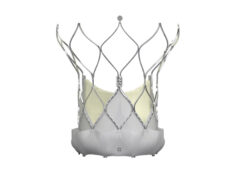 Full one-year follow-up from the Evolut Low Risk trial has upheld earlier findings from the study, demonstrating that transcatheter aortic valve implantation (TAVI) is non-inferior to surgical aortic valve replacement (SAVR) for all-cause mortality or disabling stroke at two years. The analysis, presented by Michael J Reardon (Methodist DeBakey Heart & Vascular Center, Houston, USA) on behalf of the Evolut Low Risk investigators at a hotline session at PCR e-Course 2020 (25–27 June), also projected that TAVI is cost-effective for low-risk patients in the USA and, depending on country-specific factors, it may also be the case in Europe.
Full one-year follow-up from the Evolut Low Risk trial has upheld earlier findings from the study, demonstrating that transcatheter aortic valve implantation (TAVI) is non-inferior to surgical aortic valve replacement (SAVR) for all-cause mortality or disabling stroke at two years. The analysis, presented by Michael J Reardon (Methodist DeBakey Heart & Vascular Center, Houston, USA) on behalf of the Evolut Low Risk investigators at a hotline session at PCR e-Course 2020 (25–27 June), also projected that TAVI is cost-effective for low-risk patients in the USA and, depending on country-specific factors, it may also be the case in Europe.
The Evolut Low risk trial is a prospective international multicentre randomised trial. It found that TAVI was non-inferior to SAVR for the primary endpoint of the estimated two-year rate of all-cause mortality or disabling stroke, based on a Bayesian study design. At that time, 850 of the 1,403 as-treated patients had been followed through one year. All eligible patients have now completed follow up to one year and are included in the current analysis.
Reardon explained: “The objective was to report the complete one year follow up of the Evolut Low risk trial with a focus on the implications for healthcare costs related to the use of TAVI versus SAVR in patients at low operative risk. A health economic model was used to project scenarios of long-term survival and to evaluate cost-effectiveness.”
At two years’ post-procedure, the rate of the primary endpoint of all-cause mortality or disabling stroke was 4.4% for TAVI versus 6.6% for surgery.
Reardon added: “Time in the cath lab or OR [operating room] was statistically superior for TAVI [p<0.0001]; hospital length of stay was statistically superior for TAVI [p<0.0001]; discharge straight to home was statistically superior for TAVI [p<0.0001]. New pacemaker [implantation rate] was statistically superior for surgery both in year one and year two [p<0.001]. Acute kidney injury was statistically superior for TAVI in year one and year two [p<0.01].”
The investigators created a health economic model of life year and quality adjusted life years (QALY) gains, using different projections: “We made two different assumptions; one was an optimistic assumption of a small observed mortality benefit from TAVI and surgery with between six and 24 months data continues lifelong. The other was a more pessimistic assumption that general population mortality prevailed and there was no survival difference between TAVI and surgery beyond 12 months.”
The lifetime benefit of TAVI, depending on survival projections beyond 12 months using the optimistic assumption, gave a gain of 0,32 life years, and 0.57 QALYs. Using the pessimistic assumption, the gain was 0.07 life years, and 0.08 QALYs for TAVI over surgery.
A US economic analysis projects a one-year cost difference of around $4,000 in favour of surgery, and a lifetime cost difference of $5,500 to $12,500. This suggests, said Reardon, that TAVI is cost effective if the incremental cost effectiveness ratio (ICER) is used (from $21,000 to $87,000 per QALY gained).
Reardon told the online audience: “Potential drivers for cost effectiveness in Europe are different, and TAVI would be cost effective if lifetime incremental costs for the UK were less than £2,000 to £8,000, depending on whether you are using an optimistic or pessimistic assumption—the optimistic assumption actually costs you more because patients live longer with TAVI—and in Germany, France, Italy, and the Netherlands it would vary between €4,000 to €16,000, depending on whether the assumptions are optimistic or pessimistic. Is this what is going to play out in Europe? We really do not know.”
He concluded: “At one year, the rate of disabling stroke and AV [aortic valve] hospitalisations are significantly lower with TAVI compared to SAVR. For the USA, TAVI is projected to be cost-effective for low risk patients; this may hold true in the European context depending on country cost differences and willingness to pay.”










